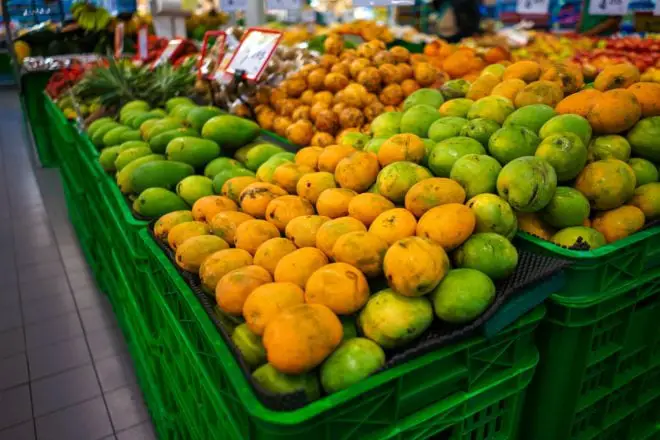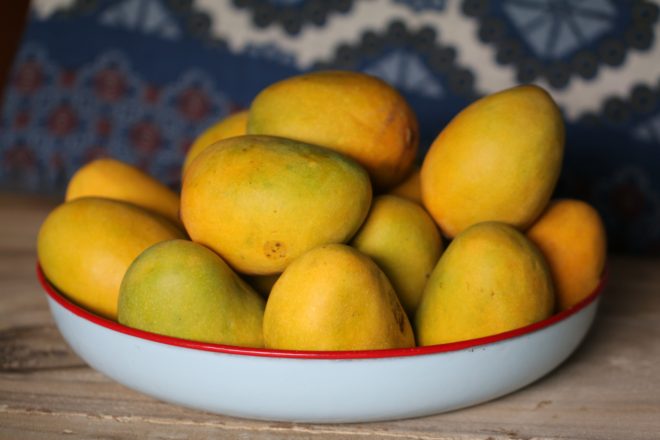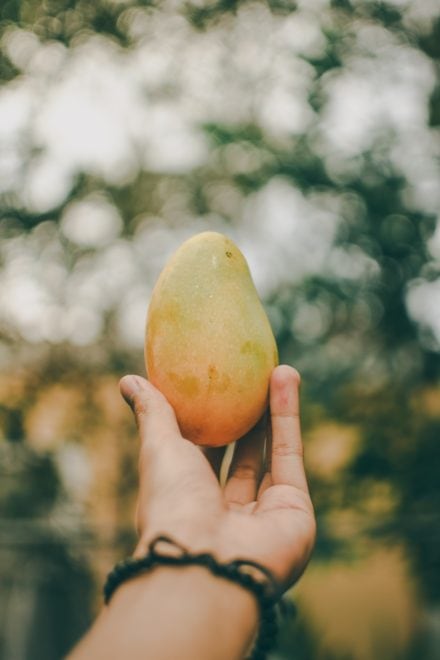Mangoes (Mangifera indica) are single-pit juicy fruit native to South Asia and distributed worldwide to become one of the most cultivated tropical fruit. The word mango (plural, mangoes) may have come from the Malay word “mangga” or from the Portuguese word “manga” during the spice trade era in Asia during the 15th and 16th centuries.
Table of Contents
The Mango Fruit
There are over 500 varieties of mangoes around the world. Most of them grow ripe by summer. The fruit itself varies in size, shape, color, sweetness, and taste. Its skin is leather-like, smooth, shiny, and smells sweet. It comes in various colors — green, bright yellow, yellow-orange, reddish-yellow, or has shades of red, pink, or purple depending on the variety. It measures from 2 to 10 inches long and weighs from 5 ounces to 5 pounds, again depending on the variety. Inside is a single flat oblong pit that is fibrous or hairy on the surface and can’t be easily removed from the flesh unless the flesh is eaten to the bone. Yummy, but it could be messy.
Cultivated To Be Eaten
Mangoes are generally cultivated and harvested to be eaten. The fruit, ripe or unripe, is widely used in different cuisines, mostly Asian. From sushi to curries; from salads to desserts; and from juice to flavoring.
Summer months mean going tropical. Tropical means lots of mangoes. But too many mangoes may lead to spoilage and the only way to save them from spoilage is to preserve them. Mangoes are versatile that they can be made into jams, pickles, chutneys, juice, candies, and dried fruit slices.

Knowing Ripe Mangoes
It’s not that easy to tell if a mango is quite ripe. Some mangoes, although bright yellow in color, may still be sour or a little bit unripe inside. Hold the mango and feel if the flesh inside is giving you a bit of a squish. It means that the flesh is tender and juicy. Then smell the end part where the stem was attached to. It will smell so sweet that you could tell it’s ripe. Mmm…
Wash the mangoes before slicing them.

How To Slice Mangoes
Before we proceed on how to dry mangoes, let us discuss on how to slice them safely.
- Using a chopping board and a knife, place the mango at the center, and cut the end of the mango (the one where the stem comes off).
- Place the mango with the cut stem side up.
- Slice down the knife on the right side of the stem, and follow the contour of the seed.
- Do the same on the left.
- With the skin side down, slice the flesh lengthwise to your desired thickness (¼ inch) without slicing the skin.
- Use a spoon to scoop out the flesh from the skin. This way, you don’t need to peel off the skin from the mango pulp. And it’s safer.
Drying Mangoes
After slicing, place the mangoes on the dehydrator trays. Pre-treatment is optional as mangoes don’t change color when exposed to air.
Set the dehydrator to 135°F for 14 hours until the slices become leathery and pliable.
Store in air-tight containers or enjoy them immediately as snacks.
Recommended Article: Ivation Electric Food Dehydrator

See at Amazon
Conclusion
Hope this short article helps you make some delicious dried mangos. I absolutely love them, and I know you will too!

